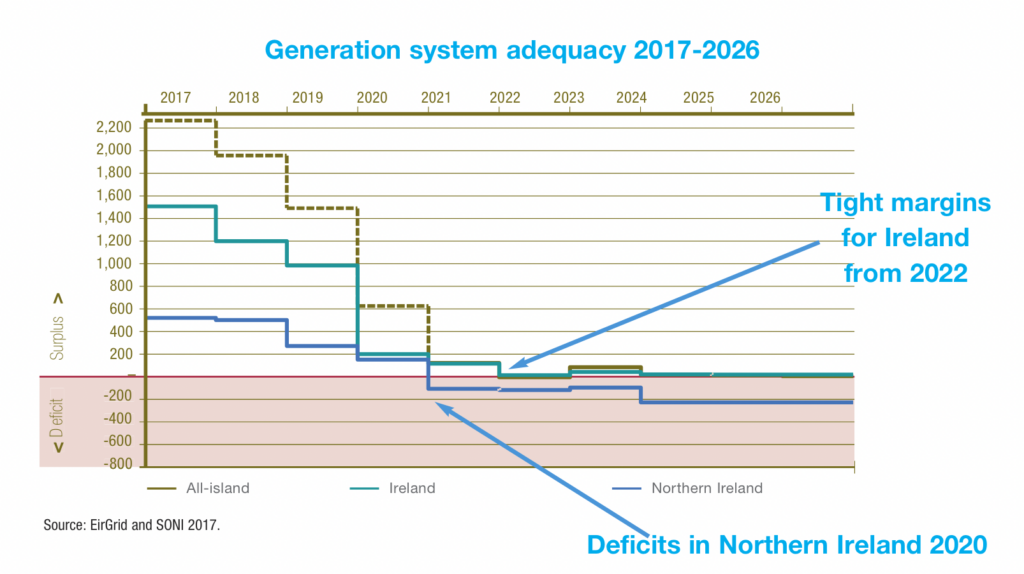
Beyond ‘brown to green’
4th October 2024
Round table discussion: Ensuring secure and stable electricity grid operations
7th October 2024Energy security in an all-island context

Refreshing the All-Island Grid Study could be a key enabler of a net zero electricity system by 2035, suggests MaREI Director Brian Ó Gallachóir.
Carried out as the first comprehensive assessment of the ability of the electrical power system to absorb large amounts of electricity produced from renewable energy sources on the island, the All-Island Grid Study of 2008 underpinned the achievement of the 2020 target to deliver a 40 per cent renewable share of electricity generation, indicates Ó Gallachóir.
Now, in the face of the pre-existing benefits of greater all-island energy integration being overlooked, not least because both jurisdictions are developing separate energy security strategies despite worrying short- to medium-term generation adequacy projections, he believes refreshing the study could serve to re-emphasise the benefits of all-island energy system integration.
Ó Gallachóir’s recommendation is delivered in a context whereby both jurisdictions have pledged to reach net zero economies by 2050, suggesting a need for a net zero energy system by 2040, underpinned by a net zero electricity system by 2035.
Stressing the importance of an integrated all-island approach to reaching this target if energy security is to be maintained, Ó Gallachóir also recommends the establishment of an all-island gas storage plan.
Context
Mapping the development of very significant all-island electricity and gas infrastructure back to 1970, when the North-South Electricity Interconnector was built, the Associate Vice-President for Sustainability at University College Cork (UCC) indicates that co-operation post-Good Friday Agreement on market and infrastructure improvements, combined with increased interconnection to the island, has prevented electricity shortfalls, despite rising demand over the past two to three decades, fueled by economic and population growth.
A further element of the all-island approach to energy infrastructure was the working partnership, and later acquisition, of the System Operator Northern Ireland (SONI) by EirGrid, to assess generation adequacy on the island as a whole.
“The Generation System Adequacy 2012-2021 gave us a 10-year projection of the surplus or deficit in terms of electricity generation and has been a continuously important tool to inform the energy market as to where there might be pinch points and potential shortfalls in electricity generation capacity,” explains Ó Gallachóir.
The system adequacy report indicated large levels of surplus electricity on an all-island basis, but highlighted tight margins for Northern Ireland from 2016 onwards in the absence of the planned second North-South Interconnector. Post-Brexit referendum, a further 10-year prediction carried out in 2017, saw even starker warnings were issued for both jurisdictions, which the academic explains has been critical to market, regulation, and policy considerations to ensure security of supply.
“Alongside the many visible benefits of the all-island single electricity market and energy infrastructure, including energy prices and security, the system adequacy report is a good example of those hidden benefits, which often go underappreciated.”
Similarly, system integration on the island has been a key enabler of the renewable electricity transition, and in particular, the growth of wind energy. This has helped to manage the significant demand growth challenge and progress was exemplified by exceeding the 40 per cent renewable penetration on the electricity grid by 2020 target.
Also significant has been the role of gas, acting as a backbone to electricity generation, while aiding the transition away from oil and coal as fuels.
Pointing to data from December 2023, a record month which saw 50 per cent of the all-island electricity demand met by renewables for more than 60 per cent of the time, Ó Gallachóir describes it as a “phenomenal achievement”, which has been underpinned by strong policy impetus.
“In the context of the all-Island single electricity market and energy infrastructure on an all-island basis, it was really the peace process which enabled that progress. Five years after the agreement was signed, the All-island Energy Market Joint Steering Group (JSG) was established, and that was followed by a number of significant developments including a memorandum of understanding between the regulators, the system operator agreement between EirGrid and SONI as transmission operators, and the common arrangements for gas,” he says.
Highlighting challenges to that early progress which have occured since the transition from the all-island Single Electricity Market to the Integrated Single Electricity Market (I-SEM) in 2018, Ó Gallachóir points to the impact of Brexit, and the subsequent increase of electricity prices.
Similarly, he describes the Policy Statement on Security of Electricity Supply (2021) and the National Policy Statement on Electricity Interconnection (2023) as “lukewarm, if not cold” on the prospect of greater interconnection with Northern Ireland. Equally, both jurisdictions could be accused of framing their energy security policies inwardly, and not on an all-island basis.
One example, he indicates, is the Government’s Energy Security in Ireland to 2030 policy document, which suggests the need for gas storage to assist with balancing the electricity system, overlooking an existing license for gas storage in salt caverns in Islandmagee, County Antrim.
“From my perspective, we have seen a period where the eye has been taken off the ball – due in part to Brexit and periods of absence of a Northern Ireland Executive – to progress all-island energy security.
“Latest projections from SONI and EirGrid show deficits in the coming years, particularly in medium and high demand scenarios, meaning that we have a problem. That speaks to the need to ensure that we do not have to rely on emergency supplies, that we can get the market mechanisms in place to enable the capacity remuneration as is required, and transform the system, particularly as we move to the ambitious targets we have set for renewables in the future.”
Pointing to existing opportunities, Ó Gallachóir highlights the emergence of a number of renewable hubs across the island as depictions of policy progression and states that approval for the second North-South Interconnector with a target commissioning date of 2026 is “welcome”.
Concluding, Ó Gallachóir says: “The 2008 All-Island Grid Study provided a really strong foundation for Ireland meeting its 40 per cent renewable electricity target. Given that both jurisdictions have committed to climate neutrality by 2050, and given our high agricultural dependence, it is suggested that we need to have a net zero power system by 2035, which is a tall order.
“I believe refreshing the All-island Grid Study would be a useful mechanism to ensuring an all-island focus on that 2035 ambition. That focus should also be turned to exploring the gas storage potential on an all-island basis.”

